If you’re searching out a replacement headset for your iPhone, you need look no further than the iMetal headsets from Maximo. They offer two models. The iP-HS1 will appeal to those people that prefer a classic style earbud fit and the iP-HS2 is for those that prefer an in-ear style fit.
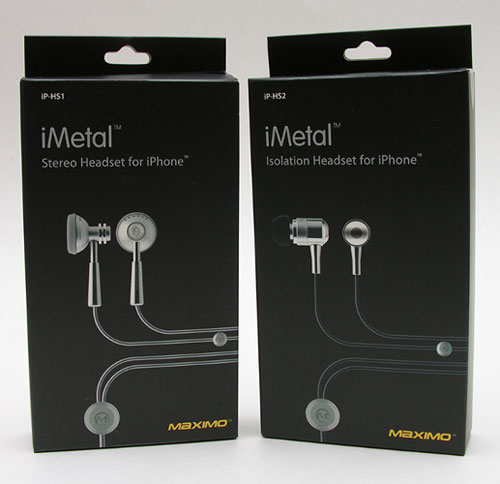
Let’s take a look at both styles and see how they compare to the stock headset that ships with the iPhone.
iP-HS1
This is the model with the classic fit.
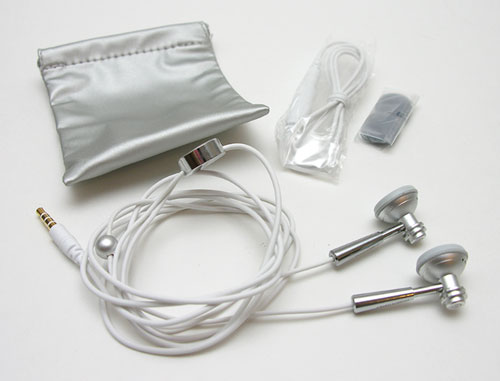
Included with the headset is a small silvery carrying pouch, a 2ft extension cable and one set of earbud covers.
Hardware Specifications
Earphone drivers: 15mm neodymium
Frequency response: 18Hz-22KHz
Sensitivity (1KHz,0.1V):>100dB
Maximum SPL output:>120dB
Microphone Sensitivity: 44dB +/-3 dB@1KHz
Microphone Frequency response: 20Hz-16KHz
Microphone impedance: 2.2K Ohm
Signal-to-noise ratio:> 58dB
Headset cable length: 4 feet
Extension cable length: 2 feet
Connection: 3.5mm with stereo audio & mono mic
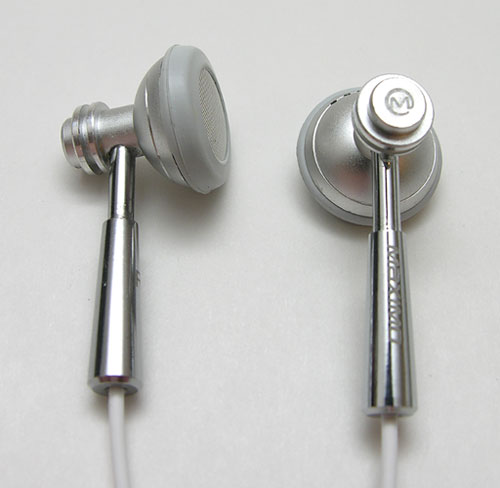
Made of a lightweight aluminum alloy body, the iP-HS1’s have a satin finish earphone, with a chrome ‘neck’. They actually feel a little heavy in hand, but that didn’t translate to discomfort while wearing them.
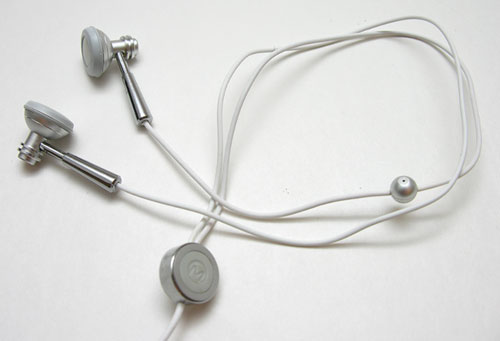
You’ll notice a small silver ball on the Left cable, approximately 4 inches below the earbud. This is the built in microphone. I like that the microphone and the call answer / end / pause switch are separate. The switch is the silver disk at the Y in the cables. The switch has a button below the grey rubber cover.
Audio quality with this headset is very good for both music and calls. I was very happy using it for both tasks. People on the other end of my calls commented on how clear I sounded. Listening to to music was enjoyable as well. Compared with the stock Apple buds, I would give the nod to the iP-HS1’s for both telephony and music.
iP-HS2
This is the model with the in-ear fit.
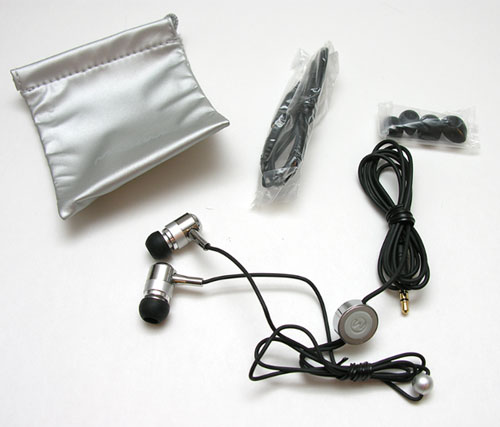
Like the iP-HS1’s, this model also includes a small silvery carrying pouch, and a 2ft extension cable. In addition, two sets of different sized silicon eartips are also included.
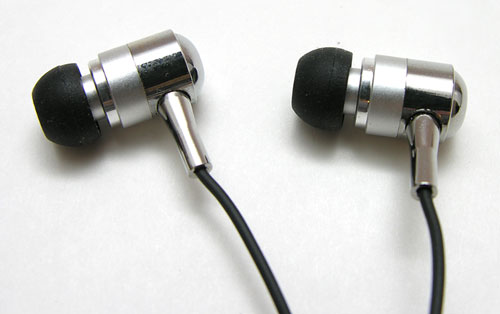
Hardware Specifications
Earphone drivers: 9mm neodymium
Frequency response: 18Hz-22KHz
Sensitivity (1KHz,0.1V):>100dB
Maximum SPL output:>120dB
Microphone Sensitivity: 44dB +/-3 dB@1KHz
Microphone Frequency response: 20Hz-16KHz
Microphone impedance: 2.2K Ohm
Signal-to-noise ratio:> 58dB
Headset cable length: 4 feet
Extension cable length: 2 feet
Connection: 3.5mm with stereo audio & mono mic
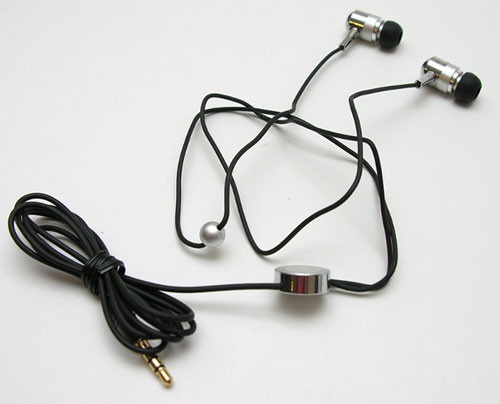
I have to say up front that in-ear style buds are not my preference. I don’t like the isolation feeling at all and have yet to find a pair that remain comfortable in my ears for even a short length of time. So, with that in mind, I will say that the iP-HS2’s didn’t feel any less comfortable than other headsets I’ve tested, such as the Skullcandy Full Metal Jacket SC-FMJI’s. So, if you like wearing this type of headset, I don’t think you’ll have any issues with fit as long as one of the three sets of ear tips work for you.
As far as sound quality, the iP-HS2’s are very good. They seem louder than the FMJ’s, but don’t have the problem with muddy overpowering bass. I actually enjoyed listening to music for the short period of time that my ears tolerated me wearing them. As with the iP-HS1’s, I had no problems with Telephony tasks. They really shine there.
I’ll be stashing my stock buds in a drawer and using the iP-HS1’s whenever I use my iPhone. If you’re interested in purchasing a set, they can be found through online retailers such as Amazon.com and Buy.com.
MAXIMO iP-ES2 iMetal Enhanced Definition Earphones Mic
$39.99 (as of December 14, 2025 18:16 GMT -05:00 - More infoProduct prices and availability are accurate as of the date/time indicated and are subject to change. Any price and availability information displayed on [relevant Amazon Site(s), as applicable] at the time of purchase will apply to the purchase of this product.)Apple iPhone (Renewed Premium) 13, 128GB, Midnight - Unlocked
(as of December 14, 2025 18:45 GMT -05:00 - More infoProduct prices and availability are accurate as of the date/time indicated and are subject to change. Any price and availability information displayed on [relevant Amazon Site(s), as applicable] at the time of purchase will apply to the purchase of this product.)Product Information
| Price: | 69.99 |
| Manufacturer: | Maximo |
| Requirements: |
|
| Pros: |
|
| Cons: |
|



Gadgeteer Comment Policy - Please read before commenting
These look nice! I will say though, the Apple Stores carry a decent pair of altec-lansing headphones called “airphones” which are designed for athletes who need to be able to hear while running, biking, etc. Not only are they great for athletics, if you use your headphones as a handsfree, it’s safe to drive with them because you’re not blocking outside noises.
carly:
Thanks for the tip on altec-lansing. I’ll try to get a pair to try out.
Three comments on the alleged 18 – 22,000 Hz frequency response claimed by these headphones –
1) Frequency response is meaningless unless you show the response curve. The rolloff at the low and high ends is probably so much that there is essentially no low or high frequency response;
2) CDs andf other program sources have essentially no output at the low and high frequency ends so that if the headphones really did have any sort of response at these limits, the program sources do not have any output there;
3) The human ear does not have any ability to hear a 22,000 Hz tone and very limited ability (if any) to hear an 18 Hz tone so, again, response at this range is useless. Most young people have caused enough damage to their ears that they have reduced hearing ability and older people have high end hearing loss as a natural part of aging.
Bottom line – these earphones may sound good but the specs are useless lies.
DON
In response to DMS: The honest way to designate frequency response is the range ± 3dB (plus or minus 3 decibels). This manufacturer may or may not be honest.
A lot of people assume the best when reading such specifications, but since many manufacturers choose to leave out that little detail about the roll-off at the low and high ends of the frequency response, one suspects that they leave it out for self-serving purposes, not for the benefit of potential customers.
It might be worthwhile querying the manufacturer directly on this matter before making a purchase.
However, regardless of how much of the named sound spectrum can actually be heard by a given individual at any volume, the sensible rule of thumb is that the broader the spectrum, the better. A practical reason for this is that as a general rule, components that honestly reproduce a broader sound spectrum will tend to have a flatter frequency response over a greater part of the spectrum reproduced.
The roll-off at the upper and lower frequencies will be there regardless of the frequency range. So, if you can get earbuds (or speakers for your living room) that don’t have serious dips in frequency response within your range of hearing, you are ahead of the game. In other words, even if you can’t hear sound at 20 Hz, but you can at, say, 30 Hz or 40 Hz, you will be better off if your speaker’s response dips more than 3 dB at 20 Hz than if it does so at 30 Hz, where you will actually be able to hear the difference.